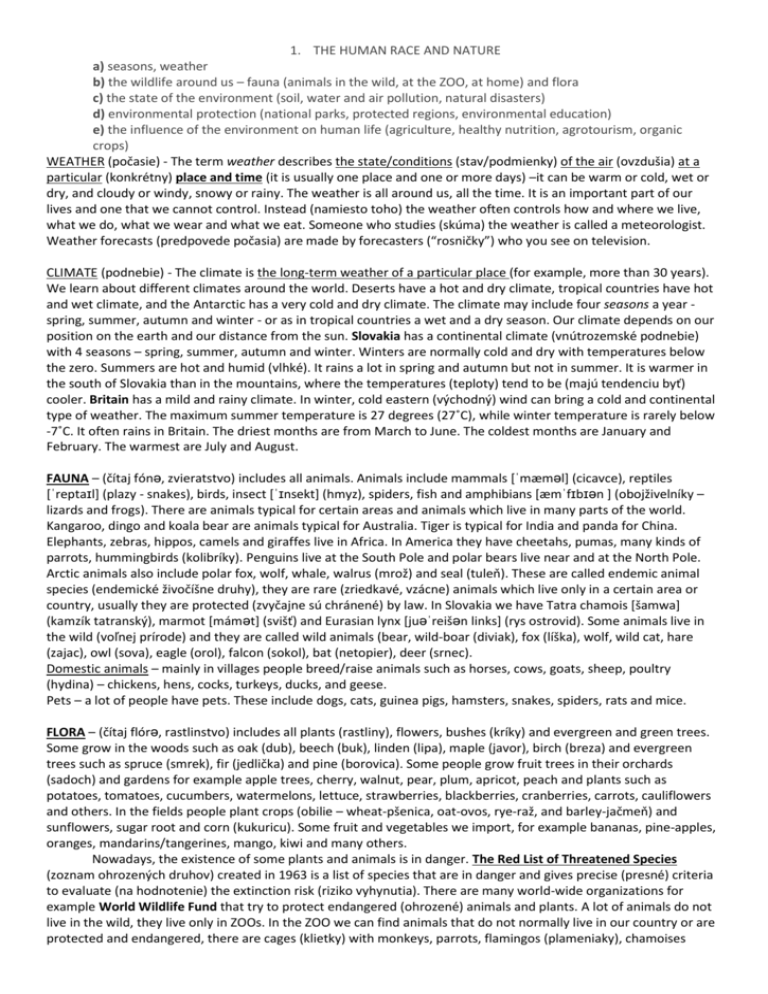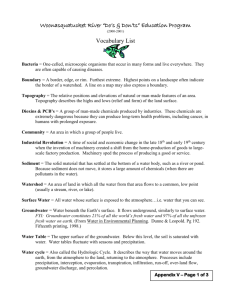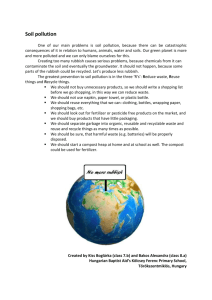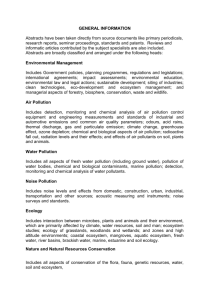THE HUMAN RACE AND NATURE a) seasons, weather b) the
advertisement

1. THE HUMAN RACE AND NATURE a) seasons, weather b) the wildlife around us – fauna (animals in the wild, at the ZOO, at home) and flora c) the state of the environment (soil, water and air pollution, natural disasters) d) environmental protection (national parks, protected regions, environmental education) e) the influence of the environment on human life (agriculture, healthy nutrition, agrotourism, organic crops) WEATHER (počasie) - The term weather describes the state/conditions (stav/podmienky) of the air (ovzdušia) at a particular (konkrétny) place and time (it is usually one place and one or more days) –it can be warm or cold, wet or dry, and cloudy or windy, snowy or rainy. The weather is all around us, all the time. It is an important part of our lives and one that we cannot control. Instead (namiesto toho) the weather often controls how and where we live, what we do, what we wear and what we eat. Someone who studies (skúma) the weather is called a meteorologist. Weather forecasts (predpovede počasia) are made by forecasters (“rosničky”) who you see on television. CLIMATE (podnebie) - The climate is the long-term weather of a particular place (for example, more than 30 years). We learn about different climates around the world. Deserts have a hot and dry climate, tropical countries have hot and wet climate, and the Antarctic has a very cold and dry climate. The climate may include four seasons a year spring, summer, autumn and winter - or as in tropical countries a wet and a dry season. Our climate depends on our position on the earth and our distance from the sun. Slovakia has a continental climate (vnútrozemské podnebie) with 4 seasons – spring, summer, autumn and winter. Winters are normally cold and dry with temperatures below the zero. Summers are hot and humid (vlhké). It rains a lot in spring and autumn but not in summer. It is warmer in the south of Slovakia than in the mountains, where the temperatures (teploty) tend to be (majú tendenciu byť) cooler. Britain has a mild and rainy climate. In winter, cold eastern (východný) wind can bring a cold and continental type of weather. The maximum summer temperature is 27 degrees (27˚C), while winter temperature is rarely below -7˚C. It often rains in Britain. The driest months are from March to June. The coldest months are January and February. The warmest are July and August. FAUNA – (čítaj fónə, zvieratstvo) includes all animals. Animals include mammals [ˈmæməl] (cicavce), reptiles [ˈreptaɪl] (plazy - snakes), birds, insect [ˈɪnsekt] (hmyz), spiders, fish and amphibians [æmˈfɪbɪən ] (obojživelníky – lizards and frogs). There are animals typical for certain areas and animals which live in many parts of the world. Kangaroo, dingo and koala bear are animals typical for Australia. Tiger is typical for India and panda for China. Elephants, zebras, hippos, camels and giraffes live in Africa. In America they have cheetahs, pumas, many kinds of parrots, hummingbirds (kolibríky). Penguins live at the South Pole and polar bears live near and at the North Pole. Arctic animals also include polar fox, wolf, whale, walrus (mrož) and seal (tuleň). These are called endemic animal species (endemické živočíšne druhy), they are rare (zriedkavé, vzácne) animals which live only in a certain area or country, usually they are protected (zvyčajne sú chránené) by law. In Slovakia we have Tatra chamois [šamwa] (kamzík tatranský), marmot [mámət] (svišť) and Eurasian lynx [juəˈreišən links] (rys ostrovid). Some animals live in the wild (voľnej prírode) and they are called wild animals (bear, wild-boar (diviak), fox (líška), wolf, wild cat, hare (zajac), owl (sova), eagle (orol), falcon (sokol), bat (netopier), deer (srnec). Domestic animals – mainly in villages people breed/raise animals such as horses, cows, goats, sheep, poultry (hydina) – chickens, hens, cocks, turkeys, ducks, and geese. Pets – a lot of people have pets. These include dogs, cats, guinea pigs, hamsters, snakes, spiders, rats and mice. FLORA – (čítaj flórə, rastlinstvo) includes all plants (rastliny), flowers, bushes (kríky) and evergreen and green trees. Some grow in the woods such as oak (dub), beech (buk), linden (lipa), maple (javor), birch (breza) and evergreen trees such as spruce (smrek), fir (jedlička) and pine (borovica). Some people grow fruit trees in their orchards (sadoch) and gardens for example apple trees, cherry, walnut, pear, plum, apricot, peach and plants such as potatoes, tomatoes, cucumbers, watermelons, lettuce, strawberries, blackberries, cranberries, carrots, cauliflowers and others. In the fields people plant crops (obilie – wheat-pšenica, oat-ovos, rye-raž, and barley-jačmeň) and sunflowers, sugar root and corn (kukuricu). Some fruit and vegetables we import, for example bananas, pine-apples, oranges, mandarins/tangerines, mango, kiwi and many others. Nowadays, the existence of some plants and animals is in danger. The Red List of Threatened Species (zoznam ohrozených druhov) created in 1963 is a list of species that are in danger and gives precise (presné) criteria to evaluate (na hodnotenie) the extinction risk (riziko vyhynutia). There are many world-wide organizations for example World Wildlife Fund that try to protect endangered (ohrozené) animals and plants. A lot of animals do not live in the wild, they live only in ZOOs. In the ZOO we can find animals that do not normally live in our country or are protected and endangered, there are cages (klietky) with monkeys, parrots, flamingos (plameniaky), chamoises (kamzíky), linxes (rysmi), lions, tigers, crocodiles, turtles, spiders and many other. In our ZOO, there is also a DINO PARK where visitors can see dinosaurs made of plastic and rubber and listen to the sounds they make. The ENVIRONMENT [ɪnˈvairənmənt] (životné prostredie) means the surroundings (prostredie, okolie) in which people, animals and plants grow and exist. The branch (vedný odbor) of biology that studies the relationships between animals, plants and humans (ľuďmi) and their environment is called ECOLOGY. In the past people were close to the nature. People did not destroy nature, they used only what they needed. They lived in caves, cut wood (drevo) and grew (pestovali) plants. They hunted and killed animas to feed their families, picked wild berries (zbierali divo rastúce bobule) and used things they found in the nature. Later they became (stali sa) farmers and raised/bred (chovali) domestic animals. They started storing food and sell it. Population started to grow. They needed more and more clear land to plant crops (na pestovanie obilia), to build more houses, to build factories to produce more goods (tovaru) and to build power stations (elektrárne) to produce more electricity. Since the Industrial Revolution people have started damaging and destroying nature. The Earth’s atmosphere and the environment have changed. Today, the world is overcrowded (there are over 6 billion inhabitants in the world). There are three basic elements we need for our life: AIR (vzduch), WATER and SOIL (pôda). Now, at the beginning of the 21st century, we are facing (čelíme) various ecological problems. The air we breathe, the water we drink and the soil we plant our foods in are all polluted (air pollution, water pollution, soil pollution). Many plant and animal species have become extinct and have disappeared. We are facing the destruction of ecosystems, sudden (náhle) changes in weather, acid rain (kyslý dážď), the global warming, the destruction of tropical rain forests and the hole in the ozone layer (diera v ozónovej vrstve). We produce a large number of dangerous chemicals (chemikálií) that endanger (ohrozujú) all life. We produce huge (obrovské) amounts (množstvá) of CARBON DIOXIDE (kysličník uhličitý – CO2). Freon used in refrigeration and plastics technologies destroys the ozone layer (ozónovú vrstvu) which surrounds (obklopuje) and protect our planed from the dangerous sunrays/sunbeams (slnečnými lúčmi). The ultraviolet radiation (UV) of the sun can cause skin cancer. Acid rain is caused by (zapríčinený) chemical SO2 (sulphur dioxide) from factories and exhaust fumes (výfukových plynov) which is mixed in the air with water from clouds and creates H2SO3 (sulphurous acid). It is dangerous and poisonous because it is an acid and it damages buildings, kills trees and pollutes the soil. All pollution is caused by chemicals which get into our water, soil and air. These chemicals are not just from factories but from products we use daily (denne), things such as laundry detergents/washing powders (pracie prášky), used to wash our clothes and pesticides and fertilizers (hnojivá) used to grow our food. The cars we use every day produce exhaust fumes which pollute our air, and the waste (odpad) and rubbish (smetie), for example packaging (obaly), paper, old bottles, plastic bottles and cans, we produce is either (buď) buried (zakopaný), polluting the soil, or (alebo) burned (spálený), polluting the air. All these chemicals get into the atmosphere or leak (preniknú, presiaknu) into the soil and pollute our water. NATURAL CATASTROPHES. Nowadays, people are facing various problems connected with weather. There are more weather –related disasters (pohromy) like tornadoes, floods (záplavy) and droughts (suchá). The temperature of our planet is rising (stúpa) and we talk about GLOBAL WARMING. The icebergs (ľadovce) are melting (topia) so the sea level (hladina mora) is rising and scientists predict that some seaside areas will disappear under the sea in the future. Earthquakes (zemetrasenia) are more frequent (častejšie). Many animal and plant species have nearly become extinct and have to be protected in national parks, zoos, and botanical gardens. In recent years, many environmental organisations have been found, some of them on international basis, such as Greenpeace. These organizations show the most serious ecological problems and do campaigns and warn people against possible consequences (varujú ľudí pred možnými následkami). They protest against nuclear power stations, against forest clearings (klčovanie lesa), building factories in the heart of nature. Many of their activities have been successful and they made governments (vlády) pass (prinútili vlády prijať) several laws to protect the environment, e.g. the use of pesticide called DDT was banned (zakázané) by law in many countries and many countries have agreed to stop Freon and other chemicals which destroy our ozone layer. Nowadays we try to protect environment in many ways. There are special bottle tanks, containers for plastic and paper waste which can be recycled and new products can be made out of it. More and more environmentally friendly products are being produced, we fill our cars with unleaded (bezolovnatý) petrol and some of them have electromotor or use gas or biofuel (biologické palivá). Special farms grow bio- vegetables and fruit (without using pesticides and chemical fertilizers) and produce bio-products. We can find them in special departments (oddeleniach) in stores or in specialized shops. Children learn about ecology and environment at school in special subject called ECOLOGY. They learn how to protect our environment, learn about possible ways of helping the mankind to survive. They learn about three basic factors to be environmentally friendly: Reduce – Reuse – Recycle (zmenšiť – znovu použiť – recyklovať). Questions: 2. Explain what it means “Reduce – reuse – recycle”. Give examples. 3. 4. 5. 6. 7. 8. 9. 10. 11. 12. 13. 14. 15. 16. 17. What is climate? What is weather? Compare the climate in Slovakia and Britain. What is the Red list of Threatened Species? Name 5 birds, animals, plants, flowers, and fish that are typical for Slovakia. Name 5 fish species and 5 other animals that live in oceans? What endemic animals do we have here in Slovakia? What is an amphibian? What is ecology? What is environment? How can you describe rainy weather? Which are the most serious ecological problems today? What causes the air pollution? What is acid rain caused by? Explain the term Global warming. How can you protect your environment? Give at least 5 examples. Name at least 5 natural catastrophes that have happened in the past 10 years. When did they happen? Explain what happened and what consequences each of the catastrophes had.







